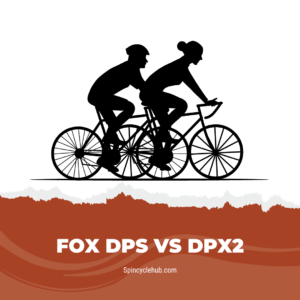Introduction
If you’re an avid mountain biker, you know that choosing the right rear shock can make a world of difference in your riding experience. Two popular options in the market are the FOX DPS and DPX2 shocks. Both offer exceptional performance, but they have their own unique characteristics that cater to different riding styles and terrains. In this article, we’ll dive into the details of FOX DPS and DPX2, compare their features, and help you decide which one is the best fit for your needs.
Understanding the FOX DPS Shock
The FOX DPS (Dual Piston System) shock is a lightweight and efficient rear shock designed for cross-country and trail riding. It features a two-position lever that allows you to switch between a firm and open mode, providing a versatile suspension setup. The DPS shock is known for its excellent pedaling efficiency, making it ideal for riders who prioritize climbing prowess without sacrificing descending capabilities.

Key Features of FOX DPS
1. Dual Piston System: The DPS shock utilizes a dual piston design, which separates the oil flow into two distinct circuits. This design enables independent control of compression and rebound, resulting in improved performance and ride quality.
2. Two-Position Lever: The DPS shock comes with a two-position lever, allowing you to toggle between “Open” and “Firm” modes. The Open mode provides a plush and active suspension for technical descents, while the Firm mode minimizes bobbing and enhances pedaling efficiency on climbs.
3. EVOL Air Sleeve: The DPS shock incorporates FOX’s EVOL (Extra Volume) air sleeve, which increases the negative air spring volume. This technology enhances small bump sensitivity and improves traction, providing a smoother ride over rough terrain.
Unveiling the FOX DPX2 Shock
The FOX DPX2 shock combines the best elements of the DPS and the larger FOX X2 shock. It is engineered to excel in aggressive trail and all-mountain riding scenarios, offering improved performance on demanding descents while still maintaining efficiency on climbs. The DPX2 shock strikes a balance between plushness and support, making it a popular choice for riders seeking versatility and control.
Key Features of FOX DPX2
1. Dual Piston System: Similar to the DPS shock, the DPX2 utilizes a dual piston system for independent control of compression and rebound. This feature allows riders to fine-tune their suspension to match the terrain and their preferences.
2. Three-Position Lever: Unlike the DPS shock, the DPX2 shock offers three compression settings – Open, Medium, and Firm. This additional “Medium” mode provides a middle ground between the plushness of Open and the efficiency of Firm, catering to a wider range of riding conditions.
3. Piggyback Reservoir: The DPX2 shock incorporates a piggyback reservoir, which increases oil volume and improves heat dissipation. This design reduces the chances of the shock overheating during prolonged descents, ensuring consistent performance throughout your ride.
DPS vs DPX2: Choosing the Right Rear Shock
Now that we’ve explored the key features of both shocks, let’s discuss how they differ and which one might suit your riding style and preferences.
1. Riding Style: If you’re predominantly focused on cross-country or trail riding with a strong emphasis on climbing efficiency, the FOX DPS shock would be a suitable choice. Its lightweight design and two-position lever make it ideal for long climbs and smoother trails.
2. Trail Versatility: If your riding style encompasses a mix of aggressive descents and technical climbs, the FOX DPX2 shock offers more versatility. With its three-position lever and piggyback reservoir, it provides a wider range of compression settings and improved heat management, ensuring optimal performance in various terrains.
3. Terrain Considerations: The type of terrain you predominantly ride on can also influence your choice. If you frequent smoother trails and prioritize pedaling efficiency, the DPS shock will deliver excellent performance. On the other hand, if you tackle rough and challenging trails with demanding descents, the DPX2 shock’s plushness and control will be more suitable.
Conclusion
When it comes to choosing between the FOX DPS and DPX2 rear shocks, it ultimately boils down to your riding style, preferences, and the type of terrain you encounter most frequently. Both shocks offer exceptional performance and incorporate FOX’s renowned suspension technology. The DPS shock excels in climbing efficiency and smoother trails, while the DPX2 shock strikes a balance between plushness and support for more aggressive riding. Consider your priorities and riding conditions to make an informed decision that enhances your mountain biking experience.

FAQs
1. Can I upgrade my existing shock to a FOX DPS or DPX2?
Yes, in most cases, you can upgrade your rear shock to a FOX DPS or DPX2, provided your frame is compatible with the necessary dimensions and mounting hardware. Consult your local bike shop or a qualified technician to ensure a proper fit.
2. Are the DPS and DPX2 shocks user-serviceable?
Yes, both shocks are designed to be user-serviceable to a certain extent. FOX provides detailed manuals and service guides on their website, and you can perform basic maintenance and tuning procedures. However, for more complex tasks, it’s advisable to seek assistance from a professional suspension service center.
3. Are there any weight differences between the DPS and DPX2 shocks?
The weight difference between the DPS and DPX2 shocks is relatively minimal. The DPX2 shock, with its additional features and piggyback reservoir, may be slightly heavier than the DPS shock. However, the weight variation is unlikely to have a significant impact on your overall riding experience.
4. Can I use the FOX DPS or DPX2 shock on my downhill bike?
While the DPS and DPX2 shocks are highly capable, they are primarily designed for cross-country, trail, and all-mountain riding. For dedicated downhill bikes, FOX offers the FOX X2 and FOX DHX2 shocks, which are better suited to handle the extreme demands of downhill riding.
5. How often should I service my FOX rear shock?
The frequency of servicing your FOX rear shock depends on various factors such as riding conditions, mileage, and personal preferences. As a general guideline, it’s recommended to have your shock serviced annually or every 50-100 hours of riding to maintain optimal performance and prolong its lifespan.
- FOX Factory: Official website of FOX Factory, the manufacturer of FOX DPS and DPX2 shocks. You can find detailed information about the shocks, technical specifications, and other products they offer.
- Pinkbike: A popular online community for mountain biking enthusiasts. Pinkbike features user reviews, forums, and articles discussing various components, including rear shocks like FOX DPS and DPX2. It’s a great resource to gain insights from fellow riders and their experiences.
Watch this one,
Video Credits – Jeff Kendall-Weed
DOWNLOAD THIS ARTICLE :Click Here
You May Also Like
-
Transition Spire vs. Sentinel: Choosing the Perfect Eyewear Companion
-
1990’s Schwinn Serial Numbers: A Guide to Decoding and Understanding Them
-
The GT Force Road Bike: Unleashing the Thrill of the Open Road
-
Schwinn Bike Criss Cross: The Perfect Blend of Comfort and Versatility



